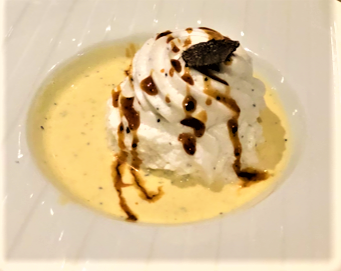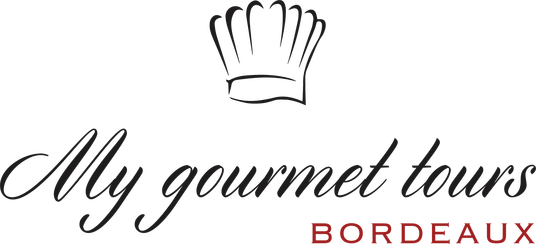Let’s plan a Gastronomic tours with My Gourmet Tours to discover the Black Diamond of Perigord: its black truffle
The magic mushroom of our Périgord lands
Who could argue that a meal with friends or in a French gastronomic restaurant is one of life’s tastiest moments?
I am lucky enough to propose and share such convivial moments with my friends or the guests of My Gourmet Tours to discover our local products and our Bordeaux gastronomy!
And as the winter season in Aquitaine is not an “off-peak” season, sad and cold as some might think, it offers us, during our gourmet walks and our gastronomic meals, its batch of exceptional products.
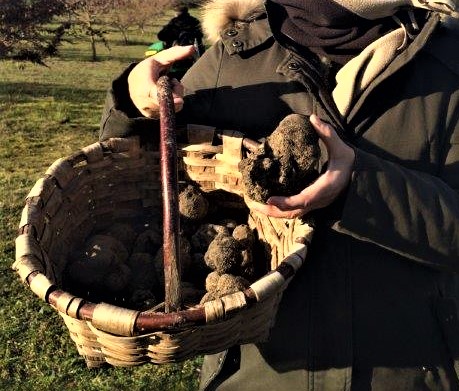
So let’s go on “caver” together with our foodies friends!
The term “caver” may seem very strange to you and perhaps you can imagine me with my friends and guests going down to the “cave” – the cellar – to taste our best Bordeaux wines?
You’re not there at all! The verb “caver” means to extract, to dig, to harvest the truffle!
The queen of flavours and traditional recipes for gastronomy in Bordeaux in particular and in France in general, the black truffle – Tuber melanosporum – has been considered since the 19th century as the “black diamond” of French cuisine.
The digging of the Périgord black truffle begins in December and ends at the end of February/beginning of March.
There are several techniques for finding truffles. The most traditional one was done using a trained sow. Nowadays most truffle growers use a well-trained truffle dog. Others, more patient, sometimes use the fly that likes to lay its eggs on this mushroom to locate mature truffles.
It is with dogs that we do the digging in the truffle farms of these passionate people who are proud of their production and their exceptional lands and that My Gourmet Tours introduces you to.
Indeed, I have the great privilege of knowing many of these truffle growers in our beautiful Aquitaine region and to be able to organize guided tours and gourmet tastings in their truffle fields, in contact with the soil and the men and women who lovingly cultivate our Black Diamond. Few shops offer truffles. They can be found in season on specialized markets or directly at the producers’. However, My Gourmet Tours has managed to find you a shop in the heart of Bordeaux to offer you a luxury Bordeaux food tour!
My Gourmet Tours, as an ambassador of the know-how of our New Aquitaine region was lucky enough to be invited to celebrate the 40th anniversary of the Doctor College of the Masters of Truffle and Foie Gras of Perigord on January 25th, in the middle of the truffle season.
And what better place than a meal at the invitation of the “Confrérie de la Truffe et du Foie Gras du Périgord” to get to know and taste this tasty and precious mushroom, king of our French and Aquitaine gastronomy?
A bit of history as we like to do at My Gourmet Tours Bordeaux…..From the wild truffle to the cultivation of the truffle
The phylloxera crisis at the end of the 19th century devastated the French vineyards and of course did not spare the production of our Bordeaux wines. The French state then offered grubbing-up premiums. Thousands of hectares of vines disappeared, leaving the place to fallow land on which oaks and… wild truffles gradually developed!
Men then try to understand how these truffles grow. The first plantations appear according to an empirical technique: one plants an acorn of producing oak with a little truffle. The results are random but considering the surfaces planted, we will harvest up to more than 1000 tons at the beginning of the 20th century.
But the two world wars, the rural exodus, and intensive agriculture have taken over truffle farming. In the 1970’s, production dropped to around 30 tons.
![IMG_0486[15529] cavage à Ribérac](https://mygourmettours.com/wp-content/uploads/2020/01/IMG_048615529-e1580467802459-300x300.jpg)
It is then that the National Institute of Agronomic Research (I.N.R.A.) looked into the problem of truffles and succeeded in producing the first certified mycorrhized trees. A new era began for truffle farming, which now has high-performance truffle plants.
We could have feared overproduction, but truffle growing does not meet the criteria of intensive agriculture. Indeed, the greater the biodiversity in a soil is, the more likely it is that production will be high. The truffle grower is therefore not trying to force nature but to find a balance in a complex ecosystem around the soil, the tree and the fungus.
Production in France remains extremely variable depending on the vintage. In 2009/2010 about 40 tons of truffles were produced, which is ten times less than the demand, hence the very high prices between 800 and 1500€ per kilogram and the crucial need to plant!
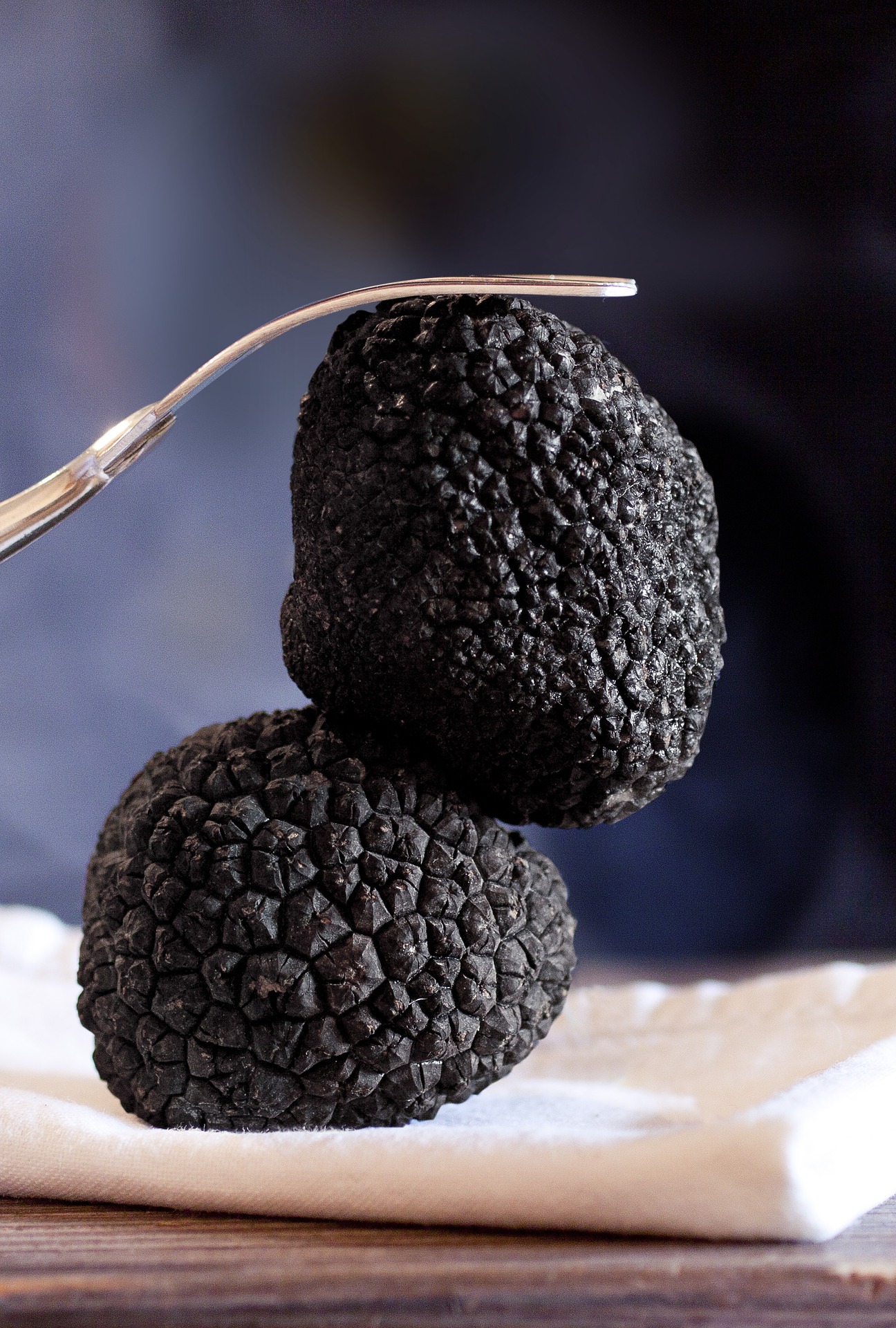
And even if the truffle cycle is very long, our patience is always rewarded!
Truffle births take place from April to June. The truffle will then develop throughout the summer and autumn and ripen in winter.
In the XXth century, and until recently, the seasons were marked differently. We had rainy springs, then rather hot summers with fairly regular thunderstorms, the autumns were cool and rainy and the winters were cold enough…
In this climatic context, the truffles had a good chance to reach maturity without too many pitfalls… In recent years, the high heat in summer and the abundant rains in autumn have tended to modify the production and the flavours of the truffle.
So the growth of the truffle passes through all the attention of the truffle growers for the truffle tree that produces it. They prune and water the oak or hazelnut tree regularly in order to create a fresh soil around the truffle and to dose the light to be brought to it. From June to September, watering has to be more abundant to fight against this increasingly dry period. Throughout the cultivation process, the soil has to be enriched, loosened (to keep the soil regular) and weeded – manually of course!
But you have to wait 5 to 8 years before the first harvest!
Truffle, tradition and recipes
If fabulous and wild black truffles exist, the culture gives excellent black truffles. The secret to tasting a good truffle is to choose its origin, its soil of origin, which is very difficult! This is why it is important to trust a professional in the matter, whose knowledge comes from his commitment to find the best truffles at all times.
From December to the end of February you can find our Black Diamond on our certified Perigord truffle markets or directly from our qualified producers. I invite you to come and discover them during one of our luxury gastronomic tours with My Gourmet Tours.
Like a precious stone, its rarity and its exceptional gustative and culinary qualities greatly inspire our French chefs but also the amateur gourmet cooks who delight those who are lucky enough to share their table or those who are lucky enough to participate in its harvest – the “cavage” – to breathe its fabulous perfume and of course to finally taste it.
Even if truffles remain reserved for luxury gourmet cooking, our favourite recipes at My Gourmet Tours remain within everyone’s reach… a few grams of truffle are enough to perfume omelettes or purées….
The simplest to taste as soon as the cavage is finished: fresh raw truffle on toast
- Spread a thin slice of white bread toasted with butter – Charentais of course! – or olive oil to stay open to the flavours of the other great truffle producing regions of southern France, Italy and Spain…or, if you have prepared it beforehand, truffle butter.
- Place on each slice of bread a slice of truffle previously brushed, washed and dried with absorbent paper or a clean cloth.
- Taste, it is simply divine for an aperitif accompanied by a Champagne or a red Pomerol, one of our finest Bordeaux wines.
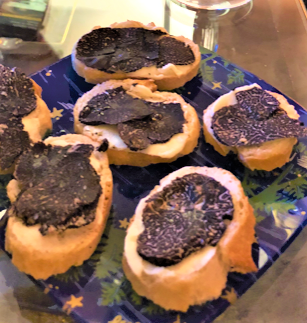
The one we prefer at My Gourmet Tours and throughout the South-West is without a doubt the truffle scramble.
It will be preferable to prepare it the day after the cavage in order to impregnate the eggs with the perfume of the truffle beforehand:
- The day before, brush, wash and dry the truffles with absorbent paper or a clean cloth. Mix them with the whole eggs in an airtight jar to be placed in the fridge – if you do this the same day leave the jar out of the fridge.
- On the same day, break the eggs in a large bowl – count 2 eggs per person – and grate the truffles generously into the egg bowl.
- Add a little milk and salt to the crème fraîche mixture.
- Beat it into an omelette with wooden utensils – avoid iron, which distorts the taste.
- Heat olive oil or better still in our region duck or goose fat in a frying pan.
- Throw the mixture from the salad bowl into the pan and stir continuously with your wooden – or silver – utensil …
- Stop cooking before the mixture turns into an omelette, still drooling but not too much…it’s up to you to measure this out…it’s scrambled eggs and not an omelette….
Taste immediately with your friends and a beautiful bottle of Bordeaux wine such as Pomerol or an Entre deux Mers – Château de L’Hoste produced by Bruno Baylet and recommended by the sommelier Bertrand Bijasson during our magnificent gastronomic dinner of the Confrérie de la truffe et du foie gras du Périgord.
The truffle is exquisite with all recipes for eggs, pasta, cooked with scallops which are in full season in winter, poultry, veal or all vegetable purées.
We love truffles, as you can see, and invite you to discover them with us during our gourmet walks in Bordeaux and Périgueux.
